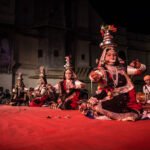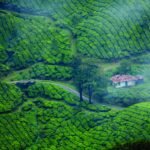Breakfast in the Hotel
After breakfast proceed on a guided tour of the city visiting
GATEWAY OF INDIA – Situated on Apollo Bunder, The Gateway of India was built to commemorate the landing of King George V and Mary in December 1911, Erected in 1924; The Gateway was designed by George Wittet in an Indo Saracenic style with influence from Gujarat. It is built from local sandstone, has a central hall with a low dome and two adjoining side halls also with low domes. The Gateway was the former landing place for passengers entering Mumbai, RAJABAI TOWER, BOMBAY HIGH COURT: is one of the oldest and chartered High Courts in the Country. It has Appellate Jurisdiction over the State of Maharashtra, Goa, and Daman & Diu, DABBAWALLA: Dabbawallah is a person in India, most commonly in Mumbai, who is part of a delivery system that collects hot food in lunch boxes from the residences of workers in the late morning, delivers the lunches to the workplace, predominantly using bicycles and the railway trains, and returns the empty boxes to the worker’s residence that afternoon. They are also used by meal suppliers in Mumbai, where they ferry ready, cooked meals from central kitchens to the customers and back, MARINE DRIVE – Eulogized by Bollywood, Marine Drive caresses the seashore from Nariman Point to the foot of the Malabar Hill. Passing Chowpatty Beach, Marine Drive is also famous as the Queen’s Necklace. One of the busiest roads in Mumbai, it is also one of the breeziest due to its proximity to the sea, CHOWPATTY BEACH,
HANGING GARDEN, MANI BHAVAN, DHOBI GHAT– A unique feature of Mumbai, the dhobi is a traditional laundryman, who will collect your dirty linen, wash it, and return it neatly pressed to your doorstep. All for a pittance. The “laundries” are called “Ghats”: row upon row of concrete wash pens, each fitted with its own flogging stone. The clothes are soaked in sudsy water, thrashed on the flogging stones, then tossed into huge vats of boiling starch and hung out to dry. Next they are ironed and piled into neat bundles. The most famous of these Dhobi Ghats is at Saat Rasta near Mahalaxmi Station where almost two hundred dhobis and their families work together in what has always been a hereditary occupation, CHATRAPATI SHIVAJI TERMINUS: formerly Victoria Terminus, and better known by its abbreviation CST or Bombay VT) is an historic railway station in Mumbai which serves as the headquarters of the Central Railways. It is one of the busiest railway stations in India, and serves Central Railway trains terminating in Mumbai as well as the Mumbai suburban railway. The station was designed by Frederick William Stevens, a consulting architect in 1887-1888, for the princely sum of 16.14 lakh rupees. Stevens earned the commission to construct the station after a masterpiece watercolor sketch by draughtsman Axel Haig. After earning the commission, Stevens went on a ten-month trip to Europe to make a detailed study of the stations there. The final design bears some resemblance to St Pancras station in London. It took ten years to complete and was named “Victoria Terminus” in honors of the reigning Queen Victoria, FORT – The Fort area in Mumbai is choc-a-bloc with old Victorian, Gothic buildings. An important financial and commercial center this area is always full of activity. The BSE or the Bombay Stock Exchange on Dalal Street is also located in this area, THE JEHANGIR ART GALLERY, COLABA – The hub of tourist activity in Mumbai, Colaba is known for its street stalls, cafes and kitsch ambience. Colaba is also home to the most pocket friendly guesthouses and economy hotels. PRINCE OF WALES MUSEUM – The foundation stone of this magnificent building was laid by King George C in 1905 on the occasion of his first visit to India. The building was designed by George Wittet and is an Indo Saracenic Style. The main museum was completed in 1914 and was temporarily used as a hospital during the World War I.
Overnight stay at the Hotel in Mumbai
































